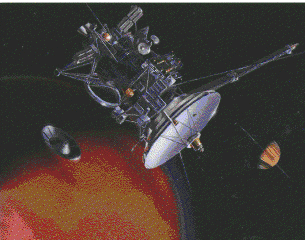
Cassini

The Cassini Orbiter's mission consists of delivering a probe (called Huygens, provided by ESA) to Titan, and then remaining in orbit around Saturn for detailed studies of the planet and its rings and satellites. The principal objectives are to: (1) determine the three-dimensional structure and dynamical behavior of the rings; (2) determine the composition of the satellite surfaces and the geological history of each object; (3) determine the nature and origin of the dark material on Iapetus' leading hemisphere; (4) measure the three-dimensional structure and dynamical behavior of the magnetosphere; (5) study the dynamical behavior of Saturn's atmosphere at cloud level; (6) study the time variability of Titan's clouds and hazes; and, (7) characterize Titan's surface on a regional scale. The spacecraft was originally planned to be the second three-axis stabilized, RTG-powered Mariner Mark II, a class of spacecraft developed for missions beyond the orbit of Mars. However, various budget cuts and rescopings of the project have forced a more special design, postponing indefinitely any implementation of the Mariner Mark II series.
Cassini is currently planned to take a similar tour of the solar system as did Galileo, referred to as a VVEJGA (Venus-Venus-Earth-Jupiter Gravity Assist) trajectory. Several opportunities exist for Cassini to make observations of asteroids, although exact encounters remain to be determined after the spacecraft has been launched as it depends on the launch date. Current plans call for an arrival in June 2004. Shortly after entering orbit around Saturn, Huygens will separate from the Cassini orbiter and begin its entry into the atmosphere of Titan. Cassini is then expected to make at least 30 loose elliptical orbits of the planet, each optimized for a different set of observations.
Cassini's instrumentation consists of: a radar mapper, a CCD imaging system, a visible/infrared mapping spectrometer, a composite infrared spectrometer, a cosmic dust analyzer, a radio and plasma wave experiment, a plasma spectrometer, an ultraviolet imaging spectrograph, a magnetospheric imaging instrument, a magnetometer, an ion/neutral mass spectrometer. Telemetry from the communications antenna as well as other special transmitters (an S-band transmitter and a dual frequency Ka-band system) will also be used to make observations of the atmospheres of Titan and Saturn and to measure the gravity fields of the planet and its satellites.
Venus page
Earth page
Moon page
Asteroid & Comets page
Jupiter page
Saturn page
Cassini Plasma Spectrometer (CAPS)
Cosmic Dust Analyzer (CDA)
Composite Infrared Spectrometer (CIRS)
Ion and Neutral Mass Spectrometer(INMS)
Imaging Science Subsystem (ISS)
Magnetometer (MAG)
Magnetospheric Imaging Instrument(MIMI)
Radio and Plasma Wave Science (RPWS)
Ultraviolet Imaging Spectrograph (UVIS)
Visual and Infrared Mapping Spectrometer (VIMS)
Radioisotope Thermal Generators (RTGs) (Answers to questions about Cassini's use of radioactive materials for power generation)